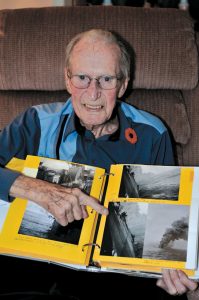Eighty-nine-year-old Second World War veteran Gilbert Davis was not only the stoker mechanic on board HMC Ships Merrittonia and Bellechasse, he was also an inadvertent photojournalist.
During his six years of service escorting merchant navy ships across the Atlantic, and minesweeping in the Pacific, he took hundreds of photos.
“One of the first things I owned was a camera; it was nothing like the fancy cameras they have now. I bought it for about a dollar fifty,” he recalls from his home off Gorge Road in Victoria.
Cameras on ships were a rarity, and Davis was one of maybe two sailors on board fortunate to have one.
“The navy didn’t like the idea of cameras because the photographs might fall into enemy hands, and if there were photos of sensitive things, it may give the enemy an advantage. I never developed any of the photographs until after the war when I was back in Moose Jaw,” he says.
He’d keep the rolls of film from his Kodak 127 Baby Brownie box camera in his footlocker. Each roll took 12 photos.
His photos ranged from posing with shipmates on Douglas Street in Victoria, to the hard reality of a sailor’s life at sea.
His favourite photo was taken when HMCS Merrittonia was being fuelled at sea by an oiler.
“I took those photos back then for my own keeping. My photos reflect day-to-day life in the Royal Canadian Navy aboard a convoy escort ship, whereas the embedded reporters of today are more often trying to get the spectacular photos of combat,” he says.
One photo he took of a sailor being rescued from a torpedoed ship showed up in a special edition of Reader’s Digest Canadians at War years after the war ended.
“I was very surprised to find my photo in a major publisher’s hard-cover specialty book, especially a large two-page spread of it,” said Davis. “I knew without a doubt that it was my photo and I never provided it to them. It’s hard to guess how they came to obtain a copy.”
Davis thinks that when he took the film in to be developed somebody kept a second copy of his images.
“My photo was published and printed without my permission or acknowledgement,” he adds.
Readers Digest formally apologized when Davis approached the Canadian publisher.
“The original publish date was 1969 and they no longer had any records or files on hand to reference regarding it. If nothing else, it felt good that we set the record straight for our own sake,” he says.
While the memories of many Second World War veterans are fading, Davis, with help from his step-son David Witzer, has recorded his story into a 51-minute narrative video on You Tube, using his photographs as visual reference.
Davis thinks Canadian Forces members would find the video interesting to compare with their own service experiences.
“Seeing bi-planes on an aircraft carrier fashioned from an old freighter is something they probably wouldn’t expect from the Second World War, and certainly that seems so primitive compared to today’s navy fleets. I also hope that young school students might find the video a good learning tool rather than having to see other more vivid examples of the war. The one thing that I think is evident in the video is the sense of camaraderie and moments other than combat. Maybe that video might spark someone’s interest to begin their own service with the Canadian Forces. There were many rewarding moments and experiences,” he says.
To see his video, go to YouTube and search for Royal Canadian Navy – A WW2 Personal Documentation by Gilbert OS Davis.
Shelley Lipke, Staff Writer










